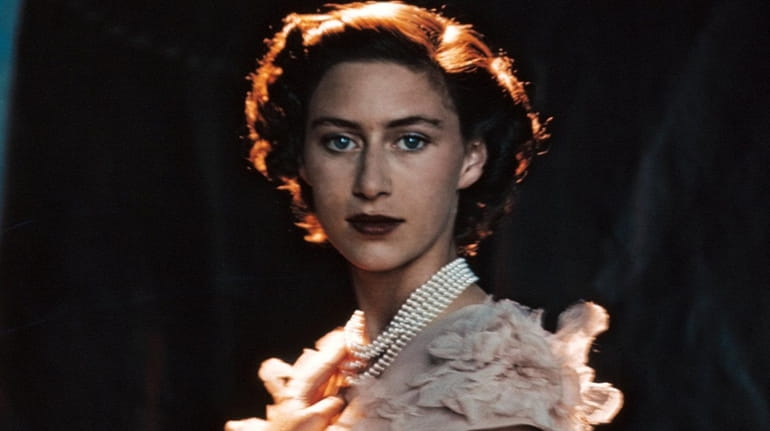'Ninety-nine Glimpses of Princess Margaret' review: Craig Brown's portrait of a royal is daring, entertaining

Princess Margaret in 1949. The queen's younger sister, largely forgotten by contemporary royal watchers, is the subject of a new book. Credit: Bettmann Archive/Bettmann
NINETY-NINE GLIMPSES OF PRINCESS MARGARET, by Craig Brown. Farrar, Straus and Giroux; 423 pp., $28.
Princess Margaret, Queen Elizabeth II’s beautiful, reckless, perennially heartbroken younger sister, is everywhere and nowhere in British history in the second half of the 20th century. Running his finger down the index of books by artists, writers and comedians, her irreverent biographer Craig Brown spots her “sandwiched for eternity” between the illustrious — Marie Antoinette — and the pedestrian — the scruffy English seaside town of Margate, where she has a namesake avenue. “What is she doing there?” he asks.
One easy answer is, well, not much. Hers was a life of singular uselessness, runner-up in the royal potato-sack race and slipping further behind with the birth of every niece and nephew. In the everyday civilian sense, what she does is show up, cut the ribbon on the supermarket or the old people’s home, attend ceremony after ceremony of rote speeches and rigid smiles. She sleeps late and breakfasts on vodka and orange juice. She is desired and wooed and abandoned. She smokes. She keeps people waiting.
It’s a remarkable achievement on the part of Brown, a columnist for the British satirical magazine Private Eye, to build a book as entertaining, daring and moving as "Ninety-Nine Glimpses of Princess Margaret" around this shell of a woman. The chief events of Margaret’s life are conveyed in the first three pages, through official proclamations issued between 1930 and 2006: birth, a proposal refused, a proposal accepted, separation, divorce, death, an auction. A Christie’s catalog tallies her life in over 800 objects, cigarette lighters and tiaras and asparagus tongs, gathered and unsentimentally flogged by her children for millions of pounds. What does that leave behind?
Royal biographers, Brown notes, are a species divided into “fawners and psychos.” But since Margaret made bonfires of her private letters and documents before she died, he must look for her in books written by hangers-on and disloyal servants, and tease out the significance of chance encounters and coincidences. The result is a book that says as much about 20th-century British culture and history as it does about its subject. In 1930, the year of Margaret’s birth, the editor of the Sunday Express commissioned a famous astrologer, “Cheiro,” to predict the baby princess’s future. The piece was a hit, and Cheiro went on to write a regular column offering similarly vague and intriguing predictions to readers. It was the birth of the modern horoscope.
Princess Margaret’s journey from stars to stuff, from promise to legacy, spans 71 years and rumored (if unlikely) affairs with 21 people, including Mick Jagger, Dusty Springfield and her brother-in-law, the Duke of Edinburgh. Countless men were obsessed with her, including Pablo Picasso, novelist John Fowles and liberal politician Jeremy Thorpe. Playing astrologer, Brown imagines Margaret’s alternative futures, married to these men, or as queen herself. Would she be happier? How much of a life is destiny, and how much luck?
Was it destiny that brought Group Captain Peter Townsend, equerry to her father, the king, into Margaret’s life when she was 13 and he 29, married with a child? In his memoirs, Brown notes, Townsend “fails to set a date” on the beginning of his attraction, but not long after her 15th birthday, he is “clearly quite smitten.” At her sister’s coronation in 1953, she is glimpsed picking fluff off her lover’s lapel, and the affair becomes a public scandal. It’s tempting to side with young love (or youngish; Townsend was nearly 40 by then) against the ramrod backs of the guardians of protocol, but the oily, self-serving, faintly predatory Group Captain is hardly an appealing romantic hero.
As viewers of Netflix’s "The Crown" will know, she said no, anyway: their marriage would have meant the loss of royal privilege. Like her uncle, the Duke of Windsor, Margaret nursed an aggrieved attachment to status, a resentment of her dutiful sibling the monarch and a restless fascination with those other modern royals, celebrities. She liked the company of “the camp, the cultured and the waspish,” men who reveled in her glamour but mocked her behind her back. She married one, and Brown pulls no punches with him, comparing her life with the glamorous photographer Anthony Armstrong-Jones, Lord Snowdon, to the movie "Gaslight." The glimpses here are telling, and chilling, including “a note tucked into her bedside book, saying simply, ‘I hate you.’”
Is the princess, then, a victim? A powerless, eternally girlish, object of desire? But how can she be, with so much money, so much privilege, such a sharp tongue? Brown’s skill is to keep shifting the angle of vision and with it, our sympathies, creating a story considerably more fascinating than its subject deserves.

